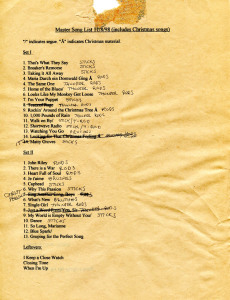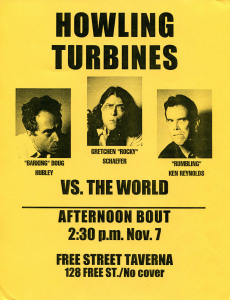Howling Turbines vs. The World
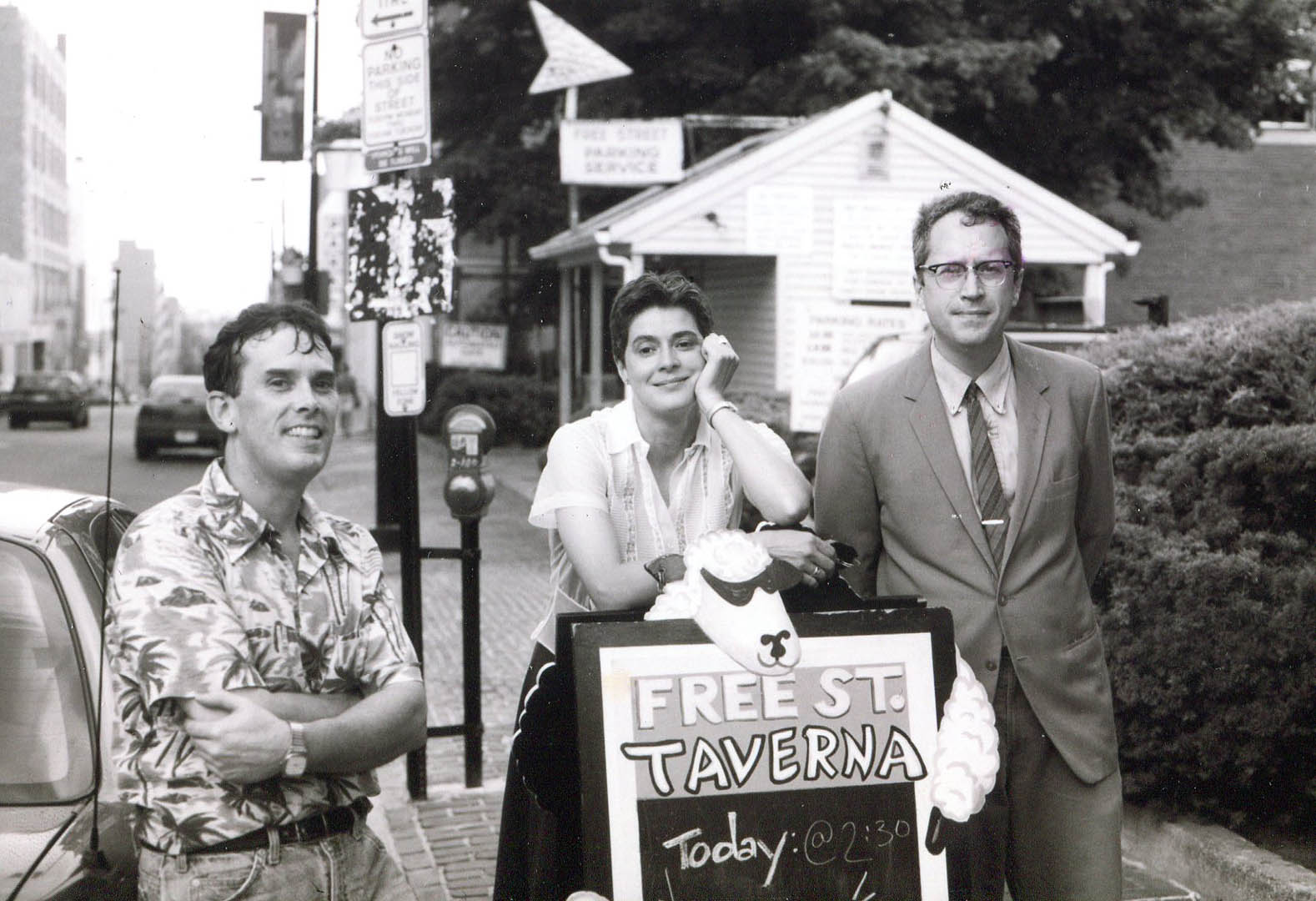
The Howling Turbines on a blistering hot day at the Free Street Taverna, Aug. 1, 1999: from left, drummer Ken Reynolds, bassist Gretchen Schaefer and me — guitarist and singer Doug Hubley. I was wearing the tan sport jacket because we had just seen “Jazz on a Summer’s Day” and I thought that tie, jacket and sweat was a great look. Photo by Jeff Stanton.
Oh no! He’s going to talk about his career again! Skip all that and go directly to the throbbing rock sounds at the Bandcamp store!
The best years of our band the Howling Turbines also happened to be my final years (to this point, anyway) as a freelance writer and editor.
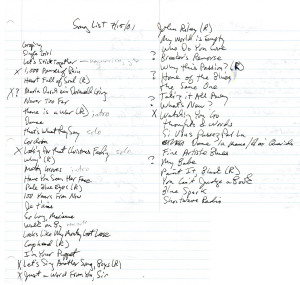
The Turbines’ repertoire in July 2001. The annotations indicate things I needed to work on. Hubley Archives.
As previously noted, the Turbines came together in February 1997, as drummer Ken Reynolds rejoined bassist Gretchen Schaefer and me after a separation of more than five years.
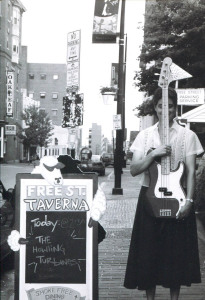
Long-necked woman with a black skirt: Howling Turbines bassist Gretchen Schaefer at the Free Street Taverna, Aug. 1, 1999. Photo by Jeff Stanton.
During those four-plus years the Turbines had the most energy, learned the most and best songs of our career, and gave the most public performances — albeit nearly all of them at the Free Street Taverna.
A surge of creativity can have many causes, and novelty is a potent one, but it’s safe to say that novelty was not the primary source of our energy during those years. In fact, familiarity and comfort may have had more to do with it.
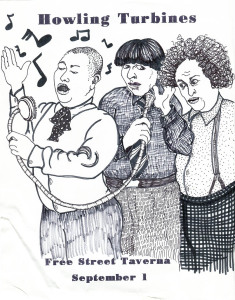
An entry in Gretchen Schaefer’s series of Howling Turbines posters based on Three Stooges publicity stills. Hubley Archives.
One of the things that made the Turbines such hot stuff early on, I believe, was an appetite for new-to-us material coupled with the confidence that we could do something good with it. Comfortable with each other personally and musically, we just had a lot of songs we wanted to try.
In those growth years of the Howling Turbines, Ken was like Santa Claus when it came to bringing in songs. I’m a lifelong Byrds fan and have the Rickenbacker to prove it, but it was Ken who proposed that we do “World Turns All Around Her,” “Have You Seen Her Face,” “Why,” “One Hundred Years From Now” and “Thoughts and Words” — one of the Turbines’ best numbers.
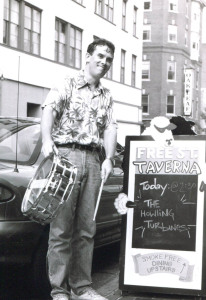
Bang a drum slowly and hold the stick lowly. Ken Reynolds at the Taverna, Aug. 1, 1999. Photo by Jeff Stanton.
Meanwhile, deep into blues and R&B, Ken nudged us in those directions as well. He sang Little Walter’s “My Babe,” and brought in Bo Diddley’s “Who Do You Love?” and “You Can’t Judge a Book by Its Cover.”
Some of Ken’s picks quickly became signature Turbines numbers. “Thoughts and Words” was one; others were Johnny Cash’s “Home of the Blues,” rendered as country-metal, and Buddy Holly’s “That’s What They Say,” propelled by Ken’s trademark rumble on the tom-toms.
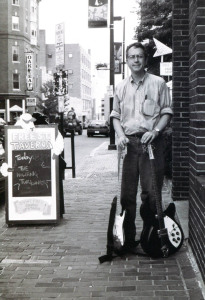
DH and the boys outside the Taverna during a Howling Turbines gig on Aug. 1, 1999. Photo by Jeff Stanton.
Not that Gretchen and I were twiddling our thumbs in the parking lot while Ken was doing all the repertoire shopping. Gretchen brought in another of our most durable songs, the Carter Family’s “Single Girl, Married Girl,” on which she sang lead.
And among my first contributions to the Turbines Hit Parade was a song I had been hankering to do for 20 years, Gene Clark’s “The Same One.” I vividly remember how great it felt as we were learning it and the pieces were falling into place, the whole suddenly transcending the sum of the parts. That’s what I’m in it for.
Who do you love?
The firm had its office downtown. I found out about it during my stint as features editor for Maine Times, an alternative newsweekly that was tottering toward the exit by the time it moved to Portland in 1994. MT and the multimedia firm were in the same building on Congress Street and shared a wall.
So even as we at the doomed MT were feeling the mass-media buzz about the brave new world of digital communications, we were hearing the merry laughter of the staff at the multimedia company next door and smelling the delicious English muffins that they toasted each morning.
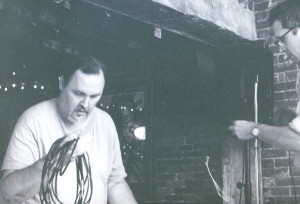
Alden Bodwell and Doug setting up the Turbines stage for a performance at the Free Street Taverna. Photo by Jeff Stanton.
Hankering for more merriment and English muffins than Maine Times could provide at that point, in August 1995 I went over the wall and got a job at the multimedia company.
Well, so much for merriment and muffins. The multimedia company and I were not a good fit. This I realized only a few weeks in, during an evening of calling state parks in Hawaii to find out how many trails and restrooms they had. Useful work, but not my work.
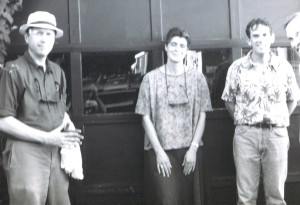
The end of a long hot afternoon: the Howling Turbines back at the rehearsal hall after a 90 F gig at the Free Street Taverna in August 1999. From left: Doug Hubley, Gretchen Schaefer, Ken Reynolds, Alden Bodwell. Photo by Jeff Stanton.
I’m not sure when the management realized our poor fit. I suppose it could have been around the time I announced I was taking a leave of absence so that Gretchen and I could travel for six weeks. In any case, I was freelancing again by April ’97 — with both my former employers ultimately among my clients.
Once again, I was living up to the mini-bio that followed my published articles — “a musician and writer living in Portland, Maine.” And yep, the band was hot stuff, nuclear batteries to power and Howling Turbines to speed.
But what didn’t happen much for this freelance writer was songwriting. I wrote two for the Turbines, “Just a Word From You, Sir” in 1997 and “Caphead” in 1998 — and that was it for my songwriting career until 2010.
Instead, I chased writing and editing assignments — getting some good ones and even a Maine Press Association award — and worried about money. And the Turbines played on.
The lack of original material is apparent in this selection of Turbines rehearsal recordings, in which only “Caphead” was written for the band; the rest are holdovers from the Fashion Jungle and the Boarders. See the album in the Bandcamp store.
-
-
- Caphead (Hubley) In the late 1990s, I started seeing all these young guys wearing ball caps, driving around in tuned Hondas and looking coldly murderous. A fatal fight among some of them in a Denny’s parking lot that year gave me the first verse. This was the last complete song I wrote before a dry spell that lasted until early 2010. Apologies to “Secret Agent Man.” From a Howling Turbines rehearsal on Aug. 8, 1999. Doug Hubley, guitar and lead vocal. Ken Reynolds, drums. Gretchen Schaefer, bass and vocal.
- Je t’aime (Hubley) This song is an interpretation, somewhat unfair to her, of an affair I had with a Swedish girl in 1976. I wrote “Je t’aime” in 1982, during the early Fashion Jungle era, revived it for the Boarders and kept it for the Howling Turbines. Aug. 8, 1999.
- Dance (Hubley) This is the final version of a song that started out in 1988 with the Fashion Jungle in a much different musical setting. Seven years later, when I needed material for the Boarders, I wrote new music for those lyrics because I couldn’t remember the Fashion Jungle’s version and didn’t realize that I had a recording of it, later unearthed. Here it is by the Howling Turbines in a rehearsal on March 22, 1998.
- Breaker’s Remorse (Hubley) Hearing the expression “buyer’s remorse” for the first time in 1987, I parlayed it into a song for the Fashion Jungle about someone who needs encouragement expressing herself. It came back with the Boarders and ended up with the HTs, who recorded this version in 1998 or ’99.
-
“Caphead,” “Breaker’s Remorse” and “Dance” copyright © 2010 by Douglas L. Hubley. “Je t’aime” copyright © 1983 by Douglas L. Hubley. All rights reserved.
Notes From a Basement text copyright © 2012-2014 by Douglas L. Hubley. All rights reserved.
